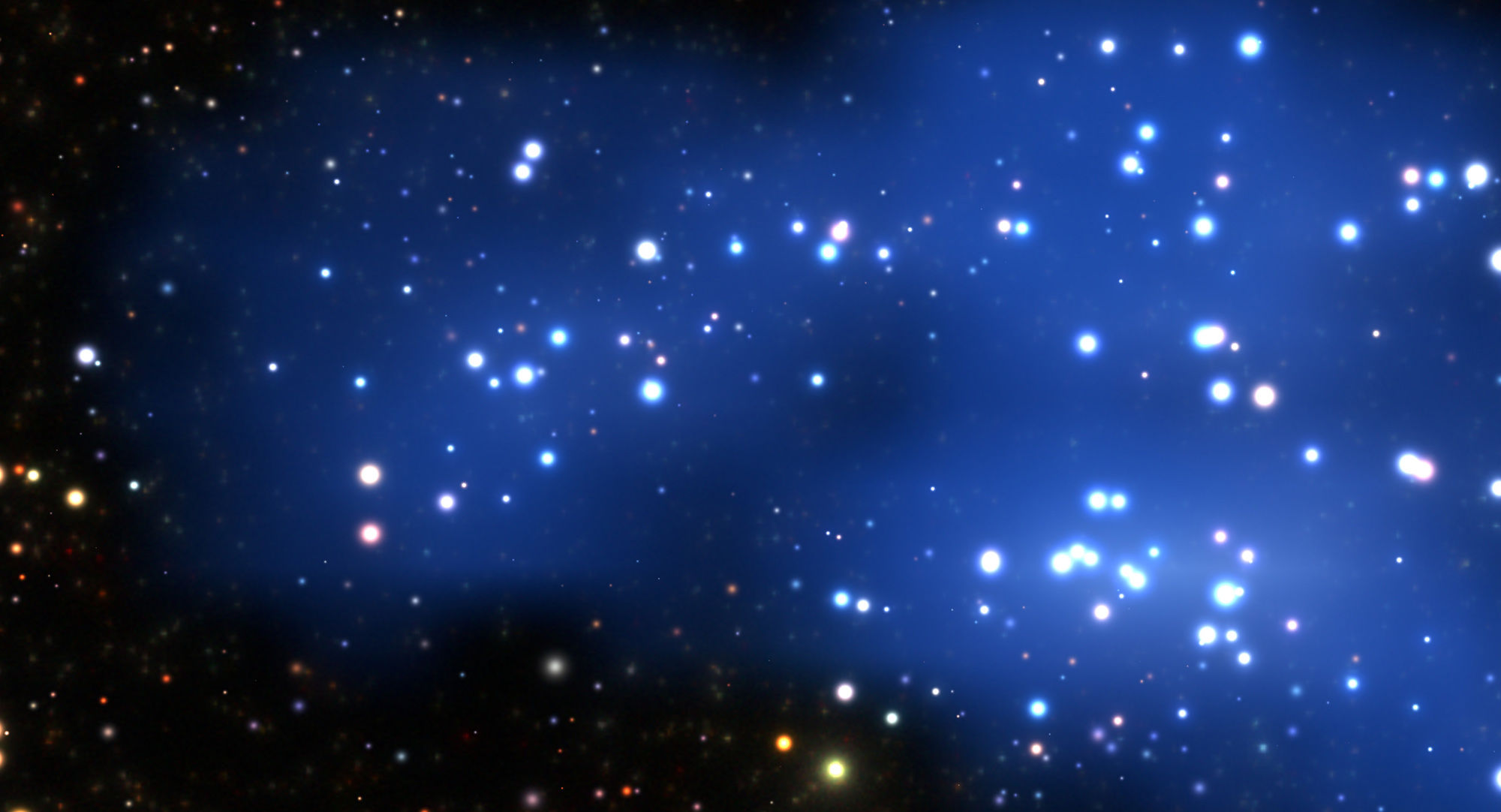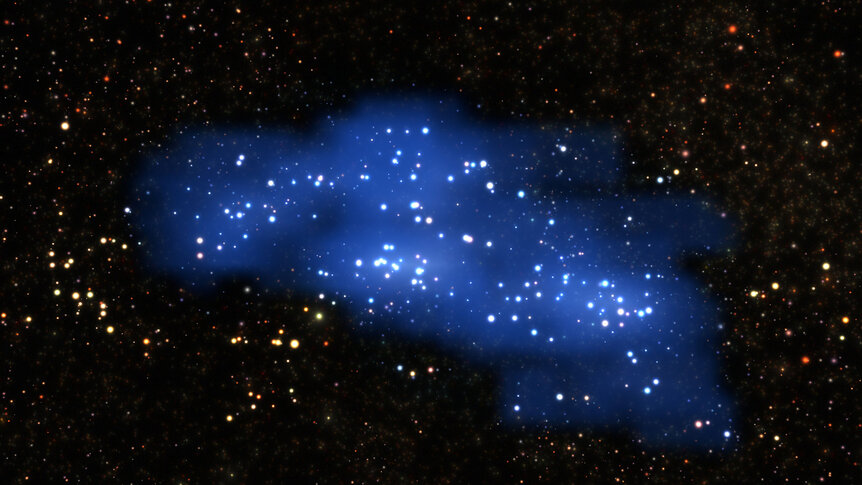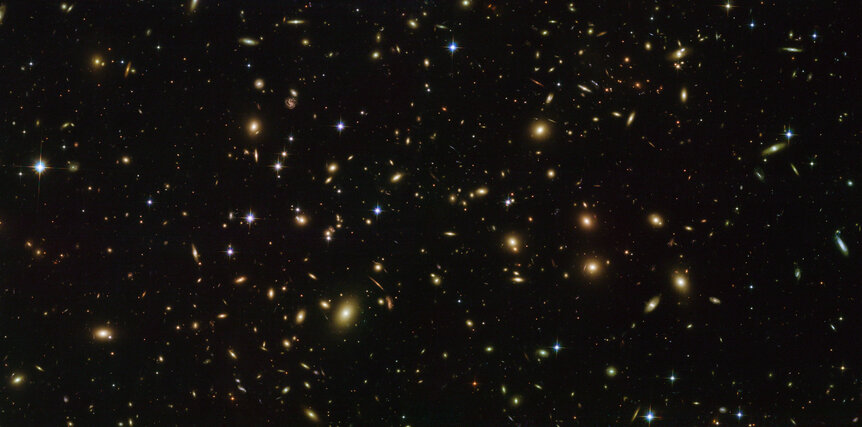Create a free profile to get unlimited access to exclusive videos, sweepstakes, and more!
A gigantic galactic city — still under construction — seen clear across the Universe

The Universe is hierarchical. That is, smaller things clump together to make ever-bigger ones: Stars hang out together in galaxies, galaxies form groups, groups form clusters, clusters form superclusters…
Well, it pretty much ends there, but it’s a helluva place to stop. Superclusters are immense structures, hundreds of millions of light years across, containing tens of thousands of galaxies. Their scale pulverizes our puny human brains into dust. They are literally the largest structures in the Universe.
Not too many are known (which isn’t too surprising; if they’re the biggest things in the Universe, how many can there be?). Weirdly, they’re so big they’re hard to see! It’s a forest-for-the-trees situation: They stretch across so much of the sky that figuring out what galaxies are in which cluster can be difficult. They also don’t have well-defined edges, instead fading out around their outer regions.
Perhaps most difficult is getting good distances to galaxies. Just because two appear next to each other in the sky doesn’t mean they’re physically close; one could be ten times farther away than the other. So knowing the three-dimension coordinates is a necessity.
It was only four years ago that astronomers were able to pin down the existence of Laniakea, the supercluster in which our Milky resides (in fact, click on that link and read that article; it goes a long way to explaining where we are here… literally), and we’re in it. So yeah, this is hard work.
A team of astronomers, though, has just announced a newly discovered supercluster, and it’s massive. Really, really massive. And huge.
They call it Hyperion, and it’s soul-crushingly enormous. It’s about 200 x 200 x 500 million light years in extent. Across its short side it’s 2,000 times bigger than our entire Milky Way. And how much stuff is in it? About 5 x 1015 times the mass of the Sun. That’s 5,000,000,000,000,000: five quadrillion. Five thousand trillion, or five million billion times our local star’s mass. The Milky Way has something like a trillion times the mass of the Sun in it, but Hyperion has five thousand times that much. It’s so big that one sub-clump, one part of it, was already named Colossus because it was so big. I mean, c’mon.
Oof.
Now, to be honest, as ridiculously huge as it is, it’s about average for a supercluster. They’re all really big. So why talk about it?
Because it’s not really a supercluster. Are you ready for this?
It’s a proto-supercluster.
Oh, I love this. What makes this one special is how far away it is, which determines its age. Most superclusters we know are either close by in a cosmic sense (like Laniakea, which we’re inside of), or a billion or two light years away.
But not Hyperion. It’s 11 billion light years away. That’s almost clear across the visible Universe. In fact, that’s key to what makes it so special: We see it as the Universe itself was only about 2.7 billion years old. That’s not enough time to form a complete supercluster! They need to simmer for much longer before becoming a true supercluster, and Hyperion isn’t there yet. It’s still in the process of settling down after collecting itself, making it a proto-supercluster. No other object like this has ever been seen locally.
Here’s how we think these things form (in a very very small nutshell). After the Universe itself got its start, it was mostly a lot of matter (both the kind we’re made of and dark matter, which is important) spread out over space, and expanding. It wasn’t evenly spread out, though: In some places it was denser than others. In those clumps the matter was dense enough that gravity could overcome the expansion, and they started to collapse.
At this point different hypotheses diverge; in one, for example, dark matter is “cold,” and able to clump together. It actually does this before normal matter can, and forms long filaments across vast stretches of space. This becomes the framework for the large structures we see today: Normal matter is attracted to the gravity of the filaments, and is drawn in. This forms huge clumps that further fragment, becoming galaxies and clusters of galaxies. And even those aggregate on a larger scale, held together by their own gravity across vast distance, becoming superclusters.
This takes time, of course, billions of years. But even as the structures themselves take shape, the substructures need to settle down, too. All that gas sliding in due to gravity stirs things up, and it’s pretty chaotic in the protoclusters. The huge blobs that will soon be galaxies are all moving around, and have barely had any time to interact with each other. That’s important. When two galaxies (or protogalaxies) pass each other over a few millions years, they exchange energy via gravity; a big galaxy gives energy to the smaller one, accelerating it. Think of it like a truck driving down the road and throwing a small pebble at the grill. The truck hardly notices, but the pebble goes flying away with a lot more energy.
Over time, the energy (in the form of velocities of the galaxies) gets redistributed. Very small galaxies might get flung away from the system, ejected after gaining enough energy. Big galaxies start to fall to the center as they lose energy. This process is called (and I love this) relaxation. Eventually, even though galaxies themselves might interact, the system as a whole doesn’t change mass. When that happens we say it’s virialized, a word taken from the Virial Theorem, which describes the energy of such a system. When a cluster is virialized, it’s pretty much done forming.
And that brings us back to Hyperion. It’s still in the process of relaxing, and hasn’t had enough time to virialize. It’s still forming. So it’s not really a supercluster, at least not yet. That’s why we say it’s a proto-supercluster.
Even so, it’s surprising to see it so far away; it wasn’t thought that such structures could be as far along as Hyperion so soon after the Big Bang. That’s very interesting! It means we still have pieces missing in our understanding of how the early Universe behaves. I’ll let you in on a secret: We already knew that. There’s lots we don’t understand. But it’s nice to see a big — a really, really big — piece of the puzzle laid out in front of us. That helps us fit the other pieces together.
Hyperion was found due to a combination of several magnificent observational programs. One, called VUDS (for VIMOS Ultra-Deep Survey, where VIMOS is a camera called the VIsible Multi-Object Spectrograph, and yes, nested acronyms are fun), targeted 10,000 galaxies (!!) in deep surveys like COSMOS (the Cosmic Evolution Survey), ECDFS (the Extended Chandra Deep Field-South Survey, taken in X-rays), and VVDS-2h (one particular observation set from the VIMOS VLT Deep Survey). These all look at very distant galaxies, trying to tease out information on these objects. VUDS was able to get distances to so many galaxies that the structure of Hyperion emerged from the data enough to be seen. Without that we wouldn’t know the three-dimensional structure, which is critical.
Without these wide-angle surveys of the sky, we’d never know what’s going out there in truly deep space. Remember, once upon a time, billions of years ago, that was us. Our own galaxy was a blob of gas and weird stuff near some others that would eventually form our Local Group, and that was near a bigger collections of blobs that would form the Virgo Cluster, and that one was near another and another and eventually we all were part of a vast buzzing proto-structure that would one day become Laniakea: Our home supercluster.
It may seem esoteric and removed from our lives, but I mean this quite literally: By studying these objects we know ourselves better, and understand better why we’re here. I don’t know of a bigger and more interesting question than that.
















